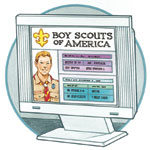
News Briefs
Enter the Boys' Life reading contest
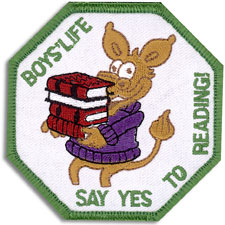
Young readers have two months left to enter the 2005 Boys' Life "Say Yes to Reading!" contest. Entrants write a report of 500 words or less in their own words on "The Best Book I Read This Year." Books can be fiction or nonfiction. Enter reports in one of three age categories: 8 years old and younger; 9 and 10 years old; 11 years and older.
The contest is open to all Boys' Life readers. All entrants receive a free Pedro patch—but only if they include a business letter-size, stamped (37 cents), self-addressed envelope with their report. (Include name, address, age, and school grade with each book report.)
First-place winners in each age category will receive a $100 gift certificate good for any product in the Boy Scouts of America Official Retail Catalog. Second-place winners will receive a $75 gift certificate, and third-place winners, a $50 certificate.
Send reports and stamped return envelopes for the free patch to Boys' Life Reading Contest, S306, P.O. Box 152079, Irving, TX 75015-2079. Entries must be postmarked by Dec. 31, 2005.
New First Class requirement
Beginning Jan. 1, 2006, an additional requirement will be added for the First Class rank in Boy Scouting.
The new requirement reads:
"Tell someone who is eligible to join Boy Scouts, or an inactive Boy Scout, about your troop's activities. Invite him to a troop outing, activity, service project, or meeting. Tell him how to join, or encourage the inactive Boy Scout to become active."
The new requirement tests the candidate's persuasive communications skills and carrying it out can help bring more boys into Scouting.
Scouts beginning work on requirements for First Class after Jan. 1, 2006, must complete the new requirement. Scouts already working on First Class requirements prior to that date will have until June 30, 2006, to complete First Class rank without completing the new requirement.
Every Scoutmaster has been sent a DVD, "In the Scout Zone" (BSA No. 18-443), containing tools in video format for young Scouts to use in completing the new requirement. One is an instruction session on how to speak to a friend about joining Scouting; another is a music video of Scout activity images to share with someone interested in joining.
Scouts can find additional support for the completion of this requirement on the Boy Scout membership Web site, www.thescoutzone.org, which is scheduled to be continually updated with helpful tools and information.
In addition, Scouts who succeed in recruiting a new Scout are eligible for a new recruiter patch (No. 18-234), which unit leaders can obtain from the council service center when they turn in a new membership application.
BSA Creates Special Fund to Restore Scouting in Areas Affected by Hurricanes Katrina and Rita
In September, in response to the devastation brought to Gulf Coast communities in Louisiana, Mississippi, Alabama, and Texas by Hurricanes Katrina and Rita, the Boy Scouts of America announced the creation of a Disaster Recovery Fund to help reestablish Scouting in those communities hardest hit by the storms.
The Web site www.scoutingfriends.org stated that the fund "is held in the BSA Foundation and will distribute 100 percent of your gift directly to families, councils, and Scout programs most affected by this tragedy."
The Web site provides for direct online contributions to the fund, either as a onetime or recurring gift at a set number of frequencies. Donations can also be sent to: Disaster Recovery Fund, c/o National BSA Foundation, Boy Scouts of America, 1325 W. Walnut Hill Ln., P.O. Box 152079, Irving TX 75015-2079.
Donors also have the option of dividing contributions between two specific areas of support:
- The Fund to Reestablish Scouting will help renovate and rebuild Scout facilities and cover emerging council financial needs.
- The BSA Employee Relief Fund provides direct assistance to the many BSA employees and their families who lost their homes, possessions, and jobs in the disaster.
***
In addition, the BSA established a special Disaster Recovery section on its Web site for the Good Turn for America (www.goodturnforamerica.org/disasterrecovery), offering guidance for packs, troops, teams, and crews wanting to assist in the relief effort.
The section includes information for contacting councils significantly impacted by the storm and a list of ideas and activities for unit involvement.
The site also provides a "Good News Stories" page, where units that have participated in the recovery process in some way can enter accounts of their efforts. Also provided are links to relief organizations such as the American Red Cross and the Salvation Army.
In addition, online forms have been added to make it easier for units in need, and units wishing to help, to report in to a special clearing center operated by the BSA's Southern Region.
BSA Youth Earn Congressional Award Gold Medal
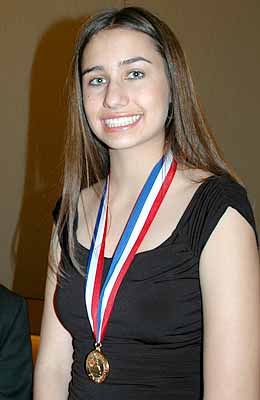 Amy DiFrancesco Photograph Courtesy Of The Venturing Division |
The Congressional Award Gold Medal was presented to 242 young adults during a June ceremony in Washington, D.C. The award is presented for achieving challenging personal goals that build character and foster community service, personal development, and citizenship. The number of recipients was the largest since the program was established by Congress in 1979.
Among the award recipients attending the ceremony was Amy DiFrancesco, who became the BSA's national Venturing president in May.
CNN White House correspondent Dana Bash, who presided at the ceremony, noted that Amy "developed Project Pride, sending cards to troops in Iraq and spent two weeks building homes for families in Mexico with Esperanza [an international organization dedicated to fighting poverty through initiatives that generate income, education, and health]."
Amy's service hours also included her involvement as a national Venturing leader and as a youth member of the Girl Scouts of Silver Sage Council Board. For the award's personal development requirement, the 16-year-old from Sun Valley, Idaho, performed in several theatrical productions and worked at a small-town general store. Amy also trained for and completed a 21-day back packing trip at the BSA's Philmont Scout Ranch. Her exploration goal included learning to sail (an experience interrupted by Hurricane Charley).
In addition to Amy, 42 other 2005 Congressional Award winners listed a BSA affiliation.
The Congressional Award is available for young people ages 14 to 23. The program has six levels—bronze, silver, and gold certificates, and bronze, silver, and gold medals—based on total hours devoted to public service, personal development, and physical fitness. Time spent on one award can be carried over to the next level.
More information is available at www.congressionalaward.org.
A partnership in preservation
Jack Blosser, director of the Ohio Historical Society's Fort Ancient State Memorial, has found a willing group of partners—local Boy Scouts—in his efforts to restore the archaeological site in southwestern Ohio to resemble the way it appeared more than 2,000 years ago.
Blosser remembers the condition of the prehistoric earthen mound when he became director in 1988, before the Scouts began working there. "It was so covered by trees, you could hardly see the earthen walls."
Fort Ancient is called a hilltop enclosure. Situated 245 feet above the Little Miami River and surrounded by 3 1/2 miles of earth walls, the site was used as a gathering place for religious and social events.
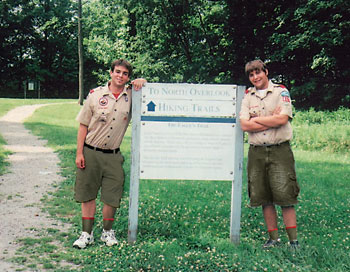 "The Eagle's Trail" recognizes projects by Scouts like Jeremy Siderits and Drew Shick. Photograph By Linda Hentschel |
Pollen evidence indicates that 2,100 years ago the site was a "pocket prairie," a small patch of grassland surrounded by forest, which, over centuries, swallowed up the prairie, Blosser explains. Hired by the Ohio Historical Society to manage the 685-acre site, he envisioned restoring a portion of Fort Ancient to a pocket prairie and preserving the enclosure.
Cost was the biggest challenge; government funds were insufficient for the task. A former Scout, Blosser decided to visit local troops and ask for assistance, offering camping sites at no charge and a historic program patch as incentives.
The Scouts responded enthusiastically and, Blosser estimates, have donated about 32,400 hours in unit service projects through June 2005, eliminating enough brush to clear about two-thirds of the enclosure. In addition, 60 Eagle Scout candidates performed their Eagle service projects at Fort Ancient, representing an additional 8,000 hours of service.
Since the first Eagle project (creating a hiking trail) in 1988, candidates have directed projects that built birdhouses, benches, bridges, boardwalks, and picnic tables. They've designed educational programs and museum exhibits, re-shingled outhouses, installed water-bars to prevent erosion along trails, and constructed an arbor to shelter drummers during the site's signature event.
The work presents special challenges. Some areas lack water. Projects must be planned around the site's program schedule. Because it is an archaeological site, all soil excavated—even for something as small as a posthole—must be sifted for artifacts.
Despite these challenges, troops from throughout Ohio continue to work at Fort Ancient. Scouts have helped to restore Fort Ancient's unusual ecosystem, preserving the underlying earthworks and increasing the site's aesthetic quality for the public.
About 30,000 visitors per year come from all around the world to learn about and enjoy Fort Ancient, which archaeologists estimate was built in about 100 B.C. during the Hopewell culture by prehistoric people sometimes called the Mound Builders.
Using bone, stone, and wood tools, the Mound Builders built many earthen mounds, from Lake Erie to the southern United States. However, evidence indicates that the Hopewells built some mounds to measurements so precise that ancient astronomers could use them for tracking the sun's movements. Archaeologists believe Fort Ancient was used as such an observatory until its builders abandoned it about A.D. 500.
As woodlands covered the enclosure, astronomical observation eventually became impossible at Fort Ancient—until the "Summer Solstice Sunrise" program of 1992, when 179 Scouts from 12 troops spent 800 hours clearing a quarter-mile swath. For the first time in centuries, observers viewed the summer solstice sunrise through a break in the earthen wall, just as prehistoric astronomers once did.
Blosser describes Fort Ancient's relationship with the Scouts as "symbiotic," benefiting both sides. Scouts who have worked there agree that they've received much from their experiences camping and visiting the site, and they welcome the opportunity to contribute something in return.
"Fort Ancient is where I had my first camp-out," explains Drew Shick of Troop 617, Kingshill, Ohio, who recently completed his Eagle service project—constructing 10 benches for the site's hiking trails. "I also had my Webelos Scout crossover ceremony here."
Jeremy Siderits, also of Troop 617, whose Eagle service project comprised assembling four "archaeology boxes" for an educational program, also recalls his troop's many camp-outs at the site. "Fort Ancient has given so much to the Boy Scouts and to our troop that I wanted to give something back," he says.
Blosser laughs when asked if he expects to eventually run out of projects.
"We've never yet turned down a Scout who wanted to work," he says. "Scouts are an integral part of the site. I don't feel that Fort Ancient could continue as it is today without them. We cannot maintain the aesthetic quality without them."
In recognition of the Scouts' work, the Ohio Historical Society named one of Fort Ancient's hiking trails "The Eagle's Trail."
—Linda Hentschel
The American Legion Eagle Scout of the Year
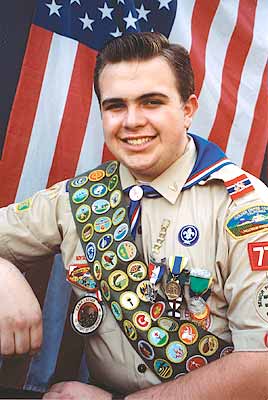 Samuel Nassie Photograph Courtesy Of The American Legion |
The award includes a $10,000 college scholarship and recognizes Samuel's practical citizenship in school, Scouting, and his church, Craig Memorial Congregational.
Samuel's threefold Eagle Scout project consisted of:
- constructing and installing redwood benches for visitors at strategic locations around Paradise Lake.
- reforesting a plot using experimental species of pine trees.
- constructing and installing wood duck nesting boxes.
His efforts to improve the environment helped Samuel earn a William T. Hornaday Award silver medal, the highest youth BSA honor for distinguished service in conservation. He also received a BSA Medal of Merit, recognizing an act of service of exceptional character, for his work on his "Veteran's Honor" project. The project involved cataloging every veteran's grave in Paradise Cemetery.
An Eagle Scout since 2001, Samuel is also an honor student. He plans to become a high school history teacher and continue his involvement in Scouting.
The American Legion also awarded a $2,500 scholarship to Jacob Hanson of Venturing Crew 940, Alpine, Utah; Bradford Held of Venturing Crew 80, Clinton, N.C.; and Tristan Holtz of Troop 328, Vancouver, Wash.
The American Legion has supported Scouting since the veterans' group's first national convention in 1919. Legion posts are chartered organizations for more than 2,500 Scouting units, serving more than 69,000 youth.
November - December 2005 Table of Contents
Copyright © 2005 by the Boy Scouts of America. All rights thereunder reserved; anything appearing in Scouting magazine or on its Web site may not be reprinted either wholly or in part without written permission. Because of freedom given authors, opinions may not reflect official concurrence.